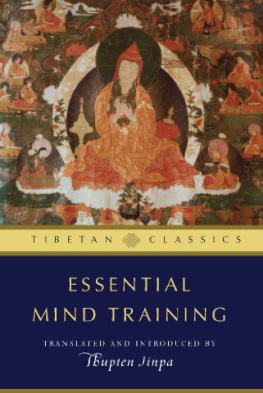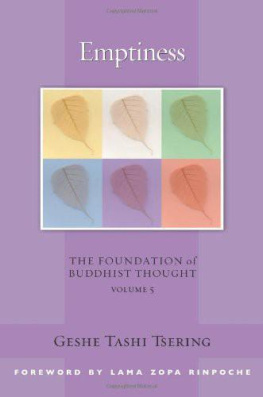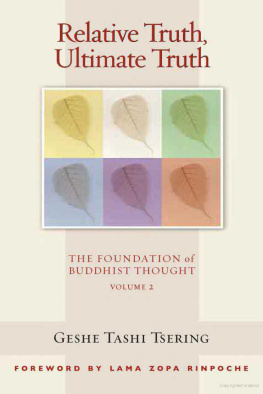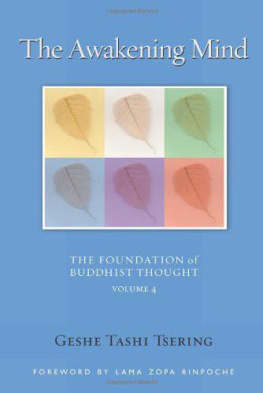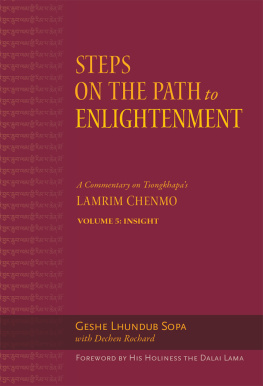Geshe Sopa is one of the rare Buddhist studies scholars with a traditional Tibetan education. This top-ranking geshe gives these rare texts the first-rate commentary they deserve.
Y ou hold in your hands one of the finest books ever published on the Kadam tradition of Tibetan Buddhism, whose basic program of mind training (lojong) was adopted by every Tibetan order. The two long poems translated here, attributed to Atias guru, Dharmaraks. ita, are among the oldest and most dramatic of the mind-training texts, full of vivid imagery, sutra and tantra practices, and both conventional and ultimate perspectives on the world.
Being learned, pure in morality, and compassionate, Geshe Sopa is an incomparable example of a Dharma teacher.
Born in Tibet in 1923, GESHE LHUNDUB SOPA moved to the United States in 1967 to teach in the Buddhist Studies Program at University of WisconsinMadison, where he is now Professor Emeritus. He founded the Deer Park Buddhist Center in Oregon, Wisconsin.
Both MICHAEL SWEET and LEONARD ZWILLING hold doctoral degrees in Buddhist Studies from the University of WisconsinMadison.
Table of Contents
Historical and Thematic Introduction
Michael J. Sweet and Leonard Zwilling
Introduction to Mind-Training Practice
Geshe Lhundub Sopa
Preface
T HIS BOOK HAS ITS GENESIS in a series of lectures that Geshe Sopa delivered at the Deer Park Buddhist Center in Oregon, Wisconsin over the course of three summer sessions, 199496, on the two texts that form its subject, The Wheel-Weapon Mind Training and The Poison-Destroying Peacock Mind Training. They were chosen in part because of their striking tone and style, which give to their message a special powerful immediacy. These homiletic poems rebuke us for our harmful thoughts and deeds by showing us their inexorable consequences: the sharp wheel-weapon of our negative karma turns fatally back upon ourselves. They exhort us to change our behavior while we are still able, to replace self-centeredness with pure altruism; they invoke the fierce protector Yamntaka to destroy the primal ignorance that is the root of egotism and thus the cause of all our suffering; and they teach us to become peacock-bodhisattvas, who can transmute the poisonous afflictions of lust, anger, ignorance, envy, and pride into the elixir of emancipation.
We want to express our gratitude to the entire lineage of teachers who have handed down and taught these texts, and to thank those who have helped to make the present book possible: William Kirtz, who was the first to translate The Wheel-Weapon into English, has been supportive of this project in a number of ways and provided the image of Yamntaka that opens part 1 of this book; those who transcribed the tapes of Geshe Sopas lectures, especially George Propps, as well as Ann Chvez, Suje Own, and James Apple. We are very grateful to Beth Newman for her invaluable editorial assistance and to John Newman and Craig Johnson for critiquing the translation at various stages. We should also like to express our appreciation to David Kittelstrom, E. Gene Smith, and all the staff of Wisdom Publications who have brought this book to fruition. May it be a source of benefit to all living beings.
Historical and Thematic Introduction

Michael J. Sweet and Leonard Zwilling
I: BACKGROUND
B OTH The Wheel-Weapon (mTshon cha khor lo)(WW) and The Poison-Destroying Peacock(rMa bya dug joms)(PDP) are early examples of the indigenous Tibetan religious literary genre known as lojong (blo sbyong), or mind training.
His tantric teaching aside, the Buddhism that Atia promulgated in Tibet
The earliest account of the three-guru tradition is found in the commentary to the well-known Seven-Point Mind Training(bLo sbyong don bdun ma) of Chad kha ba Ye shes rdo rje (110175),
2: DHARMARAKITA AND THE BODHICITTA GURU TRADITION
It is likely that the tradition of the three bodhicitta gurus emerged in the lineage of teachers who propagated the text that formed the basis for The Seven-Point Mind Training. According to Chad kha ba, the point of view represented by The Seven-Point Mind Training is that of gSer gling pa, who has always been regarded by tradition, beginning with Brom, as having been Atias chief guru; Brom is very closely associated with the transmission of gSer gling pas teachings, culminating in The Seven Points. A way of
As for Dharmarakita, he is entirely unknown to Indian tradition and whatever we know of him comes exclusively from Tibetan sources. In addition to the aforementioned work by Chad kha ba, the most important of the early sources are The Blue Udder(Beu bum sngon po) by Geshe Dol pa, a.k.a. Rog shes rab rgya mtsho, a.k.a. Dol pa dMar zhur pa (10591131), and the commentary on it by his pupil Lha bri sgang pa (twelfth century).
The scriptural and exegetical bases of their teachings are already part of the early bodhicitta guru tradition, with each guru associated with a particular sutra and religious treatise. The sutras and treatises assigned to both Maitryogi and gSer gling pa by Chad kha ba are easily identifiable from their titles, but this is not so for Dharmarakita; the title forms as they appear in Chad kha ba and Lha bri sgang pa do not permit an identification. In addition, we are also informed that neither text was ever translated into Tibetan. which in the language of Tibetan polemic indicates that it is a position with which he does not agree. This can only be understood as an explicit criticism of Dharmarakitas appropriation by the bodhicitta guru tradition as represented, for example, by Chad kha ba.
The legend of how Dharmarakita cut off his own flesh and gave it to a sick man as a medicine is an important element of the earliest traditions and is known to our three early sources; this story is repeated or alluded to forever after in association with this guru. In its earliest-known full version, which is that found in The Blue Udder commentary, the story is as follows:
If we look at the points of agreement among our three authors, we can discern what is likely to have been the basic Dharmarakita tradition namely, that he was a guru of Atias and a follower of Hinayana tenets, if not an actual Hinayanist, which is just the kind of prosaic information that has every likelihood of being historical fact. Although the flesh-cutting story does form part of the earliest tradition, we cannot say whether it is Indian or Tibetan in origin, but it is typical of the kind of pious tale associated with Indian religious figures, and its original purpose may have been to enhance the prestige of Atias teacher.
As for the flesh-cutting story, it is interesting that even at this early date what had most probably begun simply as an edifying tale was already being treated in a tendentious manner. In the introduction to the story in



